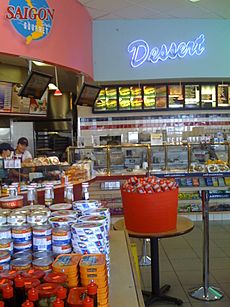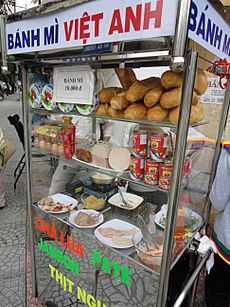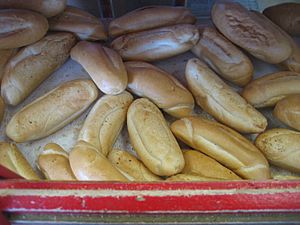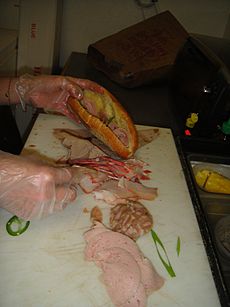Bánh mì facts for kids

A bánh mì thịt nguội prepared in San Jose, California
|
|
| Alternative names | Vietnamese roll or sandwich, Saigon roll or sandwich |
|---|---|
| Type | Sandwich |
| Place of origin | Vietnam |
| Invented | 1950s |
| Main ingredients | Vietnamese baguette (also called bánh mì) |
| Variations | See below |
Bánh mì is a super popular and tasty sandwich from Vietnam. It's made with a special kind of baguette that has a thin, crispy crust and a soft, airy inside. This bread is usually cut lengthwise and filled with lots of delicious ingredients, making it a full meal!
A typical Bánh mì sandwich is a cool mix of Vietnamese cuisine and French cuisine. It often includes Vietnamese ingredients like chả lụa (pork sausage), fresh coriander (also called cilantro), cucumber, and pickled carrots and daikon radish. From the French side, you might find creamy pâté and buttery mayonnaise. Plus, a little chili often adds a spicy kick!
There are many different kinds of Bánh mì, from those with meatballs (called xíu mại) to even ice cream! In Vietnam, people often eat these sandwiches for breakfast or as a quick snack.
The idea of the baguette came to Vietnam in the mid-1800s when France ruled the area. By the early 1900s, it was a common food. In the 1950s, a unique Vietnamese sandwich style grew popular in Saigon. It quickly became a famous street food, known as bánh mì Sài Gòn (meaning "Saigon-style Bánh mì"). After the Vietnam War, Vietnamese people who moved to other countries like Australia, Canada, and the United States helped make Bánh mì famous around the world. You can often find them in Asian bakeries in these countries.
Contents
What "Bánh mì" Means
In the Vietnamese language, the words bánh mì come from bánh (which means many kinds of baked goods, like bread) and mì (which means wheat). Sometimes, in northern Vietnam, it's spelled bánh mỳ.
When you say bánh mì by itself, it usually means "bread," especially the Vietnamese baguette. But it can also mean the delicious sandwich made with that bread.
How Bánh mì Became Popular
The word bánh mì (meaning "bread") was first written down in a Vietnamese dictionary around the 1830s. French people brought the baguette to Vietnam in the 1860s. At first, Vietnamese people in the north called it bánh tây, which means "Western bread." People in the south called it bánh mì, or "wheat bread."
Back then, French baguettes and sandwiches were quite expensive because the wheat had to be brought in from far away. They were seen as a special treat. But during World War I, more French soldiers came to Vietnam, and it became harder to get wheat from other countries. So, bakers in Vietnam started mixing cheaper rice flour into the bread. This also made the bread lighter and fluffier! Because of this, regular Vietnamese people could finally afford to enjoy bread. Many bakeries would bake bread twice a day because it can go stale quickly in Vietnam's warm weather. People often ate baguettes for breakfast with butter and sugar.
Before the 1950s, sandwiches in Vietnam were very similar to French ones, often just ham and butter with some mayonnaise or liver pâté. But in 1954, Vietnam was divided into North and South. Many people moved from North Vietnam to South Vietnam, especially to Saigon. This big move changed the food scene in Saigon a lot!
Two people named Lê Minh Ngọc and Nguyễn Thị Tịnh, who moved from the North, opened a small bakery called Hòa Mã in Saigon. In 1958, their shop was one of the first to sell bánh mì thịt (meat sandwiches). Around the same time, another person from the North started selling chả (pork sausage) sandwiches from a basket on a scooter. Soon, other stands began selling different kinds of Bánh mì.
After the Fall of Saigon in 1975, Bánh mì sandwiches became a luxury again for a while. But in the 1980s, Vietnam's economy changed, and Bánh mì made a big comeback, especially as popular street food.
Meanwhile, Vietnamese Americans brought Bánh mì sandwiches to cities across the United States. In California, Lê Văn Bá and his sons helped make Bánh mì famous through their food trucks and their fast-food chain, Lee's Sandwiches, starting in the 1980s. Sometimes, Bánh mì was compared to local sandwiches. For example, in New Orleans, a "Vietnamese po' boy" recipe even won an award!
The word bánh mì was added to the famous Oxford English Dictionary on March 24, 2011. This shows how well-known and loved this sandwich has become around the world! On March 24, 2020, Google even celebrated Bánh mì with a special Google Doodle on its homepage.
What's Inside Bánh mì
The Bread
The Vietnamese baguette used for Bánh mì has a thin, crispy crust and a soft, airy inside. It's often made with a mix of wheat flour and rice flour.
Besides being used for sandwiches, this bread is also eaten with other dishes, like bò kho (a beef stew) or curry. Some people even dip it in condensed milk for a sweet treat!
The Fillings
A Bánh mì sandwich usually has one or more kinds of meat, some fresh vegetables, and tasty sauces.
Common vegetables include fresh cucumber slices, cilantro (the leaves of the coriander plant), and pickled carrots and white radishes. These pickled veggies are called đồ chua. For sauces, you might find spicy chili sauce, sliced chilis, Maggi seasoning sauce, and creamy mayonnaise.
Different Kinds of Bánh mì
There are so many different fillings you can find in a Bánh mì! A typical Bánh mì shop in the United States might offer at least 10 different types.
The most popular kind is bánh mì thịt, which simply means "meat Bánh mì." A very common one is bánh mì thịt nguội (also known as bánh mì đặc biệt, or "special combo"). This one is made with different Vietnamese cold cuts, like sliced pork, chả lụa (pork sausage), and head cheese, along with liver pâté and fresh veggies like carrots or cucumbers.
Here are some other popular types:
- Bánh mì bì (shredded pork sandwich) – This has shredded pork or pork skin, often with fish sauce.
- Bánh mì chà bông (pork floss sandwich)
- Bánh mì xíu mại (minced pork meatball sandwich) – This one has tasty smashed pork meatballs.
- Bánh mì cá mòi (sardine sandwich)
- Bánh mì pa-tê (pâté sandwich)
- Bánh mì xá xíu or bánh mì thịt nướng (barbecue pork sandwich)
- Bánh mì chả lụa or bánh mì giò lụa (pork sausage sandwich)
- Bánh mì gà nướng (grilled chicken sandwich)
- Bánh mì chay (vegetarian sandwich) – This is made with tofu or seitan. In Vietnam, you might find it at Buddhist temples during special events, but it's less common on the streets.
- Bánh mì chả cá (fish patty sandwich)
- Bánh mì bơ (margarine or buttered sandwich) – This simple version has margarine or butter and sugar.
- Bánh mì trứng ốp-la (fried egg sandwich) – This one has fried eggs with onions, often sprinkled with soy sauce. It's a common breakfast in Vietnam.
- Bánh mì kẹp kem (ice cream sandwich) – Yes, it's an ice cream sandwich! It has scoops of ice cream topped with crushed peanuts.
Today, another popular type is bánh mì que. This bread is thinner and longer than a normal Bánh mì, but it can be filled with similar ingredients.
Sandwiches like Vietnamese Bánh mì are also found in other nearby countries. In Lao cuisine, they are called khao chī (Lao: ເຂົ້າຈີ່), and in Cambodian cuisine, they are called num pang (Khmer: នំបុ័ង).
Where to Find Bánh mì

In places in the United States where many Vietnamese Americans live, you'll find lots of bakeries and fast-food restaurants that specialize in Bánh mì. Lee's Sandwiches is a well-known fast-food chain with locations in several states. They offer Vietnamese sandwiches on French baguettes (or traditional Bánh mì bread at some places) and also Western-style sandwiches on croissants. In New Orleans, Dong Phuong Oriental Bakery is famous for the Bánh mì bread they make and send to restaurants all over the city.
Even big fast-food chains have started to offer Bánh mì or Bánh mì-inspired dishes. For example, Yum! Brands (which owns KFC and Pizza Hut) has a chain of Bánh mì cafés called Bánh Shop. Jack in the Box offers a "Bánh mì–inspired" fried chicken sandwich. And in Vietnam, even McDonald's and Paris Baguette restaurants sell Bánh mì.
Images for kids
-
Bánh mì bì (shredded pork sandwich) at Eden Center
-
Bánh mì xíu mại (minced pork meatball sandwich)
See also
 In Spanish: Bánh mì para niños
In Spanish: Bánh mì para niños












